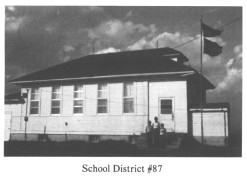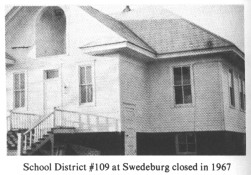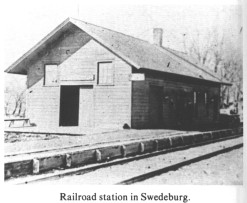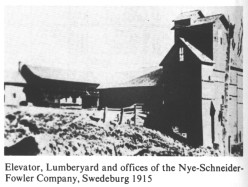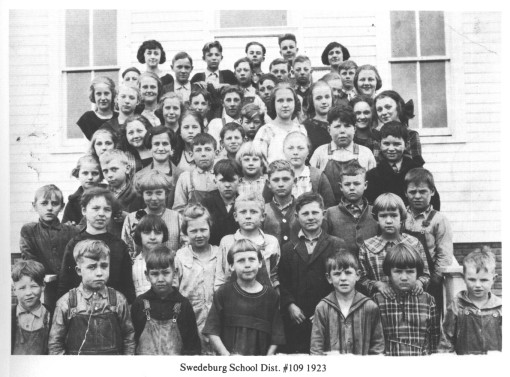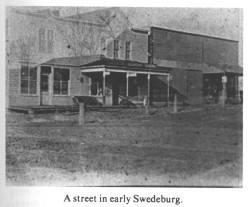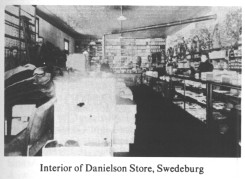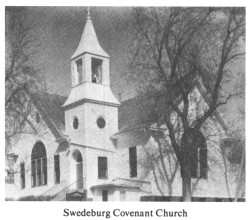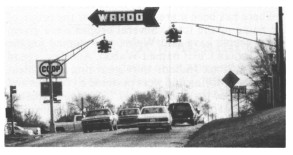 |
STOCKING PRECINCT |
Highway #77 first went through Swedeburg. It was later re-routed a mile west and the village was by-passed. Some years later its route was again changed and it now goes on the east edge of the town. A fire in the late 20's (probably 1929) destroyed the businesses along the north side of the main street, the elevators had closed, depot service had been discontinued, and on October 20, 1931 the bank was taken over by the State Department of Banking. These disasters signaled the decline of the village. The Danielson store remained open until 1947 and was opened by Mr. Mobly later. He sold out to Mr. Harold Peterson but it has been closed for many years. The rural route out of Swedeburg was discontinued in 1950 and the post office was closed in 1972. The Chicago Northwestern Railway train made the final run on September 1, 1981, and the tracks have been removed. However, both the Lutheran and the Covenant Churches continue to hold services and the houses are all occupied. These are the historical facts about a town much like any pioneer town, but what they really tell are about the people who helped carve out a town. They mastered a new language, they became farmers and businessmen and they had a sense of community. Historical facts don't tell about the struggle against the elements -- rattlesnakes in the dugouts, prairie fires, grasshoppers, drouth. They don't tell about the profound and not-so-profound discussions around the pot-bellied stove in Erickson's store, the wrestling matches in the schoolhouse-made-into-a-garage, the sack of candy that Mrs. Danielson slipped into the grocery sack whenever dad paid the charge account, the old gentleman who peddled fresh fish and warm-from-the-factory peanut butter from Lincoln, the tall tales spun by the blacksmith, the rural mail carrier who dramatically told of starting out as the sun came up and returning as the sun was setting and he had gone one mile east and one mile west through deep snow. Nor do they tell of the men who scooped more than a mile of road to get the mail into town during the 1936 blizzard or of the miles walked to deliver the mail, or the mud fought by the rural mail carrier. Many other people and incidents could be related, and we remember with respect all these people who shaped our community and our very lives.
SWEDEBURG COVENANT CHURCHThe year was 1876, and a group of Swedish immigrants met in Swedeburg, Nebraska, to organize a new church. That year of 1876 the United States was celebrating its centennial, Rutherford B. Hayes was nominated for the presidency, Alexander Graham Bell patented the telephone, the linotype was first used and the incandescent lamp was yet to be invented by Edison. Thus we see its place in history. Records show that the church was organized by a group of twenty-three families most of whom had come from Sweden in 1869. Under the leadership of Andrew Hallner they met at the home of John Martinson on August 30. The church was named the Swedish Evangelical Lutheran Mission Church, Fridhem. It was later to affiliate with the Mission Covenant Church of America when it was organized in 1885. The first officers of the church were John Martinson, chairman, A.N. Aspengren, secretary, C. Carlson, treasurer and A. Hallner, pastor. The first church was built in 1877 one mile south of Swedeburg. It was small -- 36 feet long and 24 feet wide. By 1889 more space was needed and a 12 foot addition with a gallery was added to the long side of the building. This building was struck by lightning and replaced in 1896. Later, the congregation decided to build a church in Swedeburg and the present building was erected in 1909. A parsonage and a long horse barn were also built on the site. The cemetery remains at the original church site. Andrew Hallner, the organizer and first pastor was a man of many talents and had an impact upon the county and state as well as in his church work. He came to Nebraska to attend the State Normal School in Peru in 1872-1874. In 1874, he came to teach school in Swedeburg. In 1875, he was a delegate to the Nebraska State Constitutional Congress as a delegate from Saunders County and his signature is on that document. He served one term in the state legislature. He was also an organizer of churches. The organizational meeting of the Mission Covenant Church of America was held in Chicago in 1885, and there was Andrew Hallner as a delegate from Swedeburg. He served on the constitutional committee, and was one of the seven incorporators of the Mission Covenant Church of America. This church has served the community for over a century and although the membership has decreased as is the fate of many rural churches, its influence is still a vital one in the community and through its service in world-wide Christian service. Foreign missions have always been a special concern of this church. Former members have served in foreign and home missions as well as in pastorates. The present church board includes Kenneth Carlson, chairman, Mildred Nelson, secretary, Violet Hockinson, treasurer. The sixteenth and present pastor serving the church in its over one hundred years is Rev. Robert Kronberg -- the grandson of Pastor Hallner.
WAHOOThe city of Wahoo is located in Stocking Precinct. It is the county seat, and is located about 40 miles west of Omaha and 30 miles north of Lincoln. Wahoo is located in the east-central portion of Nebraska on U.S. Highway 77 and Nebraska Highway 92. Wahoo has a second-class city rating with a two-square-mile land area. The town has continued to expand and meet the needs of its people. page 119 |
| Back | Contents | Next |
The Saunders County NEGenWeb Project
